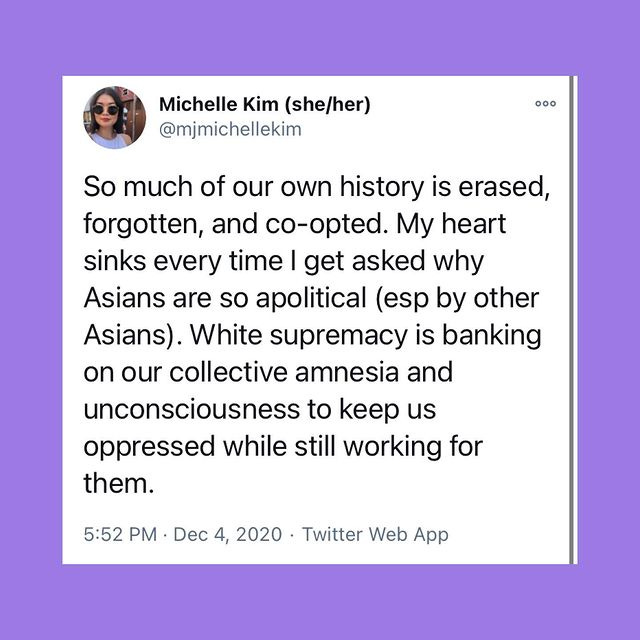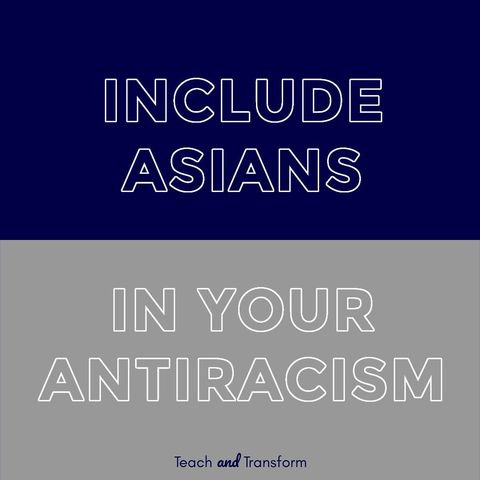Author’s Note: I wrote this newsletter two weeks ago on Sunday, January 31st before I came across devastating news about what is happening to the Asian American Pacific Islander (AAPI) communities. If you do not know what happened, please check out Next Shark to see news that has not made it to your feed.
The combination of the news, the lack of mainstream media coverage on them, the feeling of little explicit support from members of my community and other communities, and all the exhaustion of my lived experience being an Asian American in this country coming back… broke me.
I will have a follow-up newsletter that’ll bask in Asian joy, which will include cooking for Lunar New Year. Stay tuned!
🦻🏼Music👂🏼
One of my favorite Korean girl groups is MAMAMOO. This is from their rookie days:
Not Crazy or Rich, But Asian (working title)*
* If you have a catchy title suggestion, please let me know.
I mentioned in previous newsletters that I want to explore more about Asians in America. Two main reasons for this:
Reason 1: I am scared.
I am nervous about losing connections with my roots. I’ve thought about what happens after my parents leave this world and how much Asian culture I can pass on to my kids in the future. It just makes me want to soak up more things Asian (specifically Taiwanese, but I’ll take it all).
Reason 2: I am exhausted from being overlooked.
Asians in America have been erased from American society since we stepped foot on this country til this day. Very little is taught about Asians/Asians in America in school. I remember at most three paragraphs about Asians in America. My school did not even teach us about the history of our own Santa Anita Race Track, which used to be a Japanese internment camp. Seriously? The history is in our own backyard and you’re not going to teach it?!
Many communication outreach or data collection in America overlook AAPI communities. There is very little to no mainstream media coverage on the attacks that are happening to us. Even as harassment against AAPI rose early in the pandemic, California attorney general’s office refused to collect data on it so Stop AAPI Hate tracker was created. Within 4 months of its creation, more than 2,600 incidents were collected - and I believe that is a lowball number too.1
Most people who are reading this newsletter know me personally and I hope you take my word for it when I say AAPI are overlooked in this country. But if you do not (and I know some will disregard me because I have been gaslit by people I was close with)… see how many items from my short quiz below you know about - only answer yes if you are able to describe who the person is or what event I am talking about:
LA Riots
Yuri Kochiyama
Fred Korematsu
Grace Lee Boggs
Third World Liberation Front
Vincent Chin
Amanda Nguyen and the Sexual Assault Survivors’ Rights Acts
Chinese Massacre of 1871 that happened on Calle de los Negroes (Street of the Negroes)
Attacks on AAPI community between March 2020 and today, which includes lighting a grandmother on fire in Brooklyn and pushing several AAPI elderly (some have died as a direct cause)
United Farm Workers
I am not shaming anyone who does not know these events or people because I only started learning about this several years ago. The point I want to make is that AAPI have been continually erased in this country. As many of us are working on confronting the anti-Blackness within ourselves, our families and communities, please also work on the anti-Asian sentiments too. I am saying this to everybody: No matter if you are White or Black or Asian or Latinx, you can do better. I can do better. We can all be better humans, and be better neighbors to each other.
A list to start unlearning the anti-Asian sentiments that are baked into this country - this includes people of Asian descent too:
The Oprah Magazine: Racist Attacks Against Asian Americans Are Still on the Rise During COVID-19
10 Surprising Facts About Asian American Civil Rights You Never Learned in School
Read caption on this @goulding_jr post to see what actual solidarity looks like. This is applicable to any group, not just AAPI communities.
Go through this gallery by @hownottotravellikeabasicbitch on myths about Asians, including “Asians haven’t been there. Y’all are a protected class.” Spoiler: we are not. Stop telling me that I am not a person of color - I am.
If you start saying “but Asians do not have it as bad as Black people in America”, read this caption by @localpassportfamily.
And on that note, expect this segment from time to time where I share all things Asian from culture to history to current events. I am excited to share what I learn and I hope you are ready to expand your knowledge too.
Slant’d magazine
Slant’d is an independent media company founded in 2017 to “creatively untangle the complexity of being Asian American. By empowering real people to share real stories, Slant’d provides a refreshing take on the Asian American narrative and sparks an intersectional dialogue that breaks boundaries between assumption and reality.”
I first read the fourth issue of this magazine called Revolution, and was floored by the quality of its contents. Slant’d does a great job of diversifying the voices and experiences, especially because the Asian American population is so expansive with roots to over 20 countries in Asia. I highly recommend checking them out.
There was one article regarding the 150th anniversary celebration of the completion of the Transcontinental Railroad in Utah hosted by Spike 150 Foundation. I cried reading it. I do not have the magazine right now as I lent it to a friend, but this is an excerpt of another article “Why This Taiwanese American Helped Tell the Story of Chinese Railroad Workers” that shared similar sentiments:
Conspicuously absent from Andrew J. Russell’s wildly celebrated “East and West Shaking Hands at Laying of the Last Rail” 1869 photograph, commonly known as the “Champagne Photo,” are Chinese railroad workers who comprised 80-90% of the Central Pacific’s workforce.
[…] I first noticed this omission not just in the Champagne Photo but also from my Utah history lessons I had in the 7th grade. The Chinese railroad workers were asked to do the impossible and the impossible they delivered. Yet their colossal contributions were marginalized to a mere footnote.
The rest of the article I shared is worth the read. In the Slant’d article, the author wrote about prominent Asian American activists. One of them was Corky Lee.
Corky Lee
Corky Lee was an award-winning photojournalist who describes his work as “photographic justice… rectifying omissions in American history one photograph at a time. We do matter. America better get used to it”2. Was because Corky passed in January 2021 from COVID-19 complications at the age of 73.
His photography began in high school after seeing the Champagne Photo mentioned above. It inspired him to dedicate his lifetime photographing Asian Americans and Pacific Islanders to “[cement] their representation in history”3. At the 150th Transcontinental Railroad anniversary celebration, he recreated the Champagne Photo with a group of Chinese Americans and descendants of Chinese railroad laborers in the same location.
Additional links about Corky you should check out::
14-minute video “Not on the Menu: Corky Lee’s Life and Work”
7-minute video “Photographer Corky Lee: Caught In The Act”
Trailer for upcoming documentary “Photographic Justice: The Corky Lee Story”. This site also has many of his photographs from the last century.
New Yorker article “Corky Lee’s Photographs Helped Generations of Asian-Americans See Themselves”
NYT article “Corky Lee, Who Photographed Asian-American Life, Dies at 73”
That’s it for today’s “Not Crazy or Rich, But Asian”. There are many personal revelations I would like to share in upcoming newsletters. For now, check out this Instagram post for a book, a documentary, and two short podcasts for more Asian American things:
- Juliet









Hello Juliet! I really appreciated the list of resources you shared about AAPI identity. I was especially surprised when you mentioned that the Santa Anita Race Tracks used to be the place for Japanese internment.
Adjacent: I came across a Tiktok (https://www.tiktok.com/@navajorocks/video/7062107155595398447?is_from_webapp=1&sender_device=pc&web_id7045451743782864389) today that talked about why Native American reservations are located in "deserts" where there are no resources. Turns out, these places used to have a lot of water...until the forces that be like government and corporations came in and depleted the resources. It's heartbreaking to learn about this history now. On the other hand, I'm glad that our education now extends to the internet and platforms like TikTok are giving grassroots creators/educators a place to be discovered. Sadly though, the TikTok creator fund is infamous for not paying much and that's why people are turning to Youtube.
A lot of these educational resources are made based upon "passion" and for the public good, but I would love to see more BIPOC labor being paid one day. Another issue I have seen is even within the "community", people are not paying. Youtube creators Fung Bros once posted in the Facebook group Asian Creative Network (ACN) asking for ghost writers for their book...offering a very meager sum of money that was a SLAP in the face, considering their platform. They mentioned "exposure" as a form of payment 🤨All of this has led me to reconsider what "activism" can look like. I understand representation is a form of activism, but I no longer look to it as the end all be all because we can very easily elevate AAPI creators that implement shady practices like those I just mentioned.